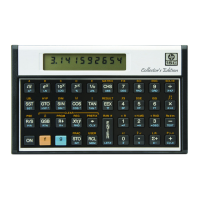148 Section 12: Calculating with Matrices
section operate on the matrices whose descriptors are placed in the X-
register and (for some operations) the Y-register.
Two matrix operations—calculating a determinant and solving the matrix
equation AX = B—involve calculating an LU decomposition (also known
as an LU factorization) of the matrix specified in the X-register.
*
A matrix
that is an LU decomposition is signified by two dashes following the
matrix name in the display of its descriptor. (Refer to page 160 for using
a matrix in LU form.)
The Result Matrix
For many operations discussed in this section, you need to define the
matrix in which the result of the operation should be stored. This matrix
is called the result matrix.
Other matrix operations do not use or affect the result matrix. (This is
noted in the descriptions of these operations.) Such an operation either
replaces the original matrix with the result of the operation (if the result
is a matrix, such as a transpose) or returns a number to the X-register (if
the result is a number, such as a row norm).
Before you perform an operation that uses the result matrix, you must
designate the result matrix. Do this by pressing ´ < followed by
the letter key specifying the matrix. (If the descriptor of the intended
result matrix is already in the X-register, you can press O <
instead.) The designated matrix remains the result matrix until another is
designated.
†
To display the descriptor of the result matrix, press l
<.
When you perform an operation that affects the result matrix, the matrix
is automatically redimensioned to the proper size. If this redimensioning
would require more additional elements than there are available in matrix
memory (a maximum of 64 for all five matrices), then the operation can’t
be performed. This restriction can often be overcome by designating the
result matrix to be one of the matrices being operated on. (However,
*
The LU decomposition of a matrix A is another matrix in which is encoded a lower-
triangular matrix, L, and an upper-triangular matrix, U, whose product LU equals matrix
A (possibly with some rows interchanged). The HP 15c Advanced Functions Handbook
discusses LU decomposition in detail.
†
Matrix A is automatically designated as the result matrix whenever Continuous Memory
is reset.

